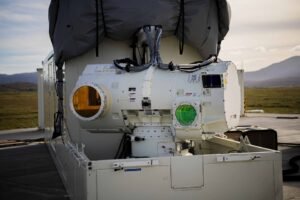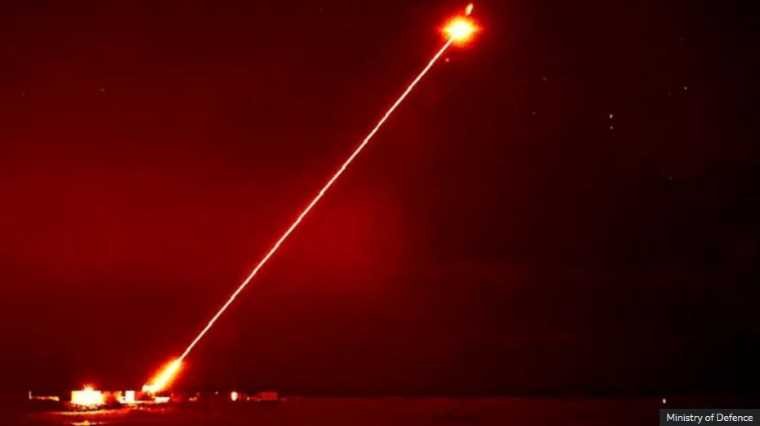The UK Ministry of Defense (MOD) has announced the successful test firing and downing of an aerial target using its high-powered DragonFire laser weapon. The exact power and range of the combat laser remain classified, but an official statement says DragonFire can hit a £1 coin-sized object from a kilometer away.
While there are no immediate plans to deliver the laser system to troops, the MoD says they are currently evaluating DragonFire and that this successful test was a critical next step toward actual deployment.
DragonFire Joins Growing List of Directed Energy Weapons
In the 1980s and 1990s, using lasers to down aerial targets remained firmly in the realm of science fiction. The U.S. Defense Department first tested a combat laser prototype in 1995, but that system required numerous buildings to operate and had limited target-destroying power.
In subsequent years more systems have been developed, with many sporting power ranges in the tens of kilowatts. Ranging from truck-mounted lasers and aircraft-mounted lasers to larger systems mounted directly on U.S. Navy ships, these lasers are not powerful enough to blast targets out of the sky. Instead, they have to stay locked on an incoming drone long enough to fry their electronics or burn off a wing.
More recently, advances in optical technology have allowed contractors like Raytheon and Lockheed Martin to steadily increase the power of these systems, with the most powerful coming in at 300kW. Dubbed the most powerful combat laser ever built, that system is currently undergoing an upgrade that will bring it up to as much as 500kW. It is possible that such a weapon could be strong enough to take down cruise missiles, something that smaller laser systems cannot do.
Perhaps the most well-known combat laser is employed by the Israeli armed forces. Dubbed Iron Beam, that system is mounted on the Israeli border to complement their Iron Dome system that uses conventional missiles to take down incoming drones and mortars. At 100kW, Iron Beam is the most potent combat laser in deployment anywhere in the world.
Now, it appears that the UK is joining the march toward adding lasers and other directed energy weapons that include powerful microwave emitters that can fry the electronics of a drone or missile to their arsenal. Along with the accuracy of these systems, the MoD is also hoping that laser systems can dramatically reduce costs.
Successful Test Shows DragonFIre is Moving Closer to Deployment
According to an official statement from the MoD, DragonFire is being led by the Defence Science and Technology Laboratory (Dstl) as well as industry partners. MBDA, Leonardo and QinetiQ.


In that same statement, the MoD says, “This milestone demonstrated the ability to engage aerial targets at relevant ranges and is a major step in bringing this technology into service.” The latest test also builds on previous work that showed how DragonFire can effectively track both air and sea targets “effectively and at range.”
“These trials have seen us take a huge step forward in realising the potential opportunities and understanding the threats posed by directed energy weapons,” said Dstl’s Chief Executive, Dr. Paul Hollinshead.
The MoD also notes the potential financial advantages of using lasers instead of missiles, which can cost as much as 100,000 pounds, to counter the increasing use of low-cost drones.
“Firing it for 10 seconds is the cost equivalent of using a regular heater for just an hour,” they explain. “Therefore, it has the potential to be a long-term, low-cost alternative to certain tasks missiles currently carry out. The cost of operating the laser is typically less than £10 per shot.”
MoD Funding Multi-Million Pound Program to Make DragonFire Ready for the Battlefield
Following the successful downing of an aerial threat, the MoD says they are moving ahead with funding a multi-million-pound program “to transition the technology from the research environment to the battlefield.” They also say that both the Army and navy are evaluating using DragonFire and similar technologies as part of their future Air Defense capabilities.
“With our decades of knowledge, skills, and operational experience, Dstl’s expertise is critical to helping the armed forces prepare for the future,” said Hollinshead.
“The DragonFire trials at the Hebrides demonstrated that our world-leading technology can track and engage high-end effects at range,” added Shimon Fhima, Director of Strategic Programmes for the MOD. “In a world of evolving threats, we know that our focus must be on getting capability to the warfighter, and we will look to accelerate this next phase of activity.”
Christopher Plain is a Science Fiction and Fantasy novelist and Head Science Writer at The Debrief. Follow and connect with him on X, learn about his books at plainfiction.com, or email him directly at christopher@thedebrief.org.

